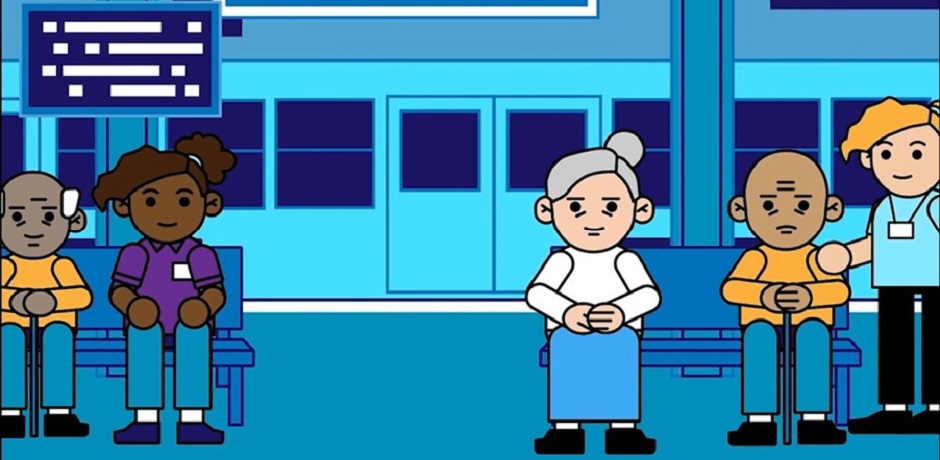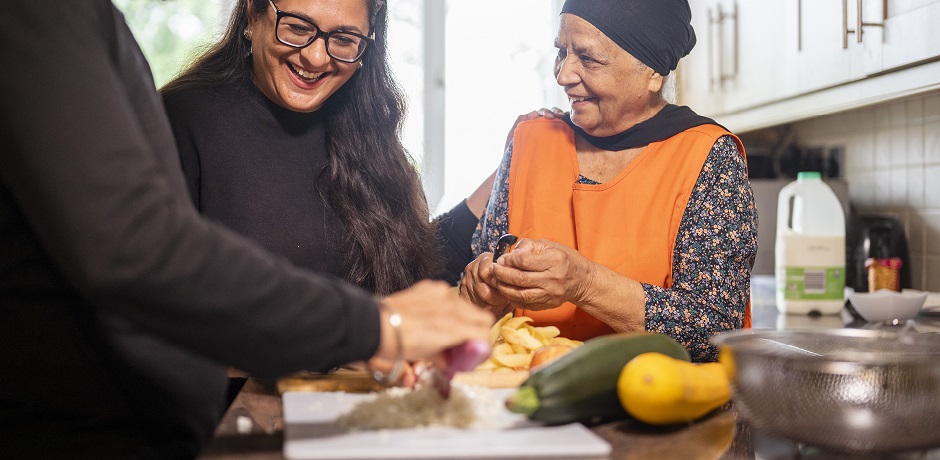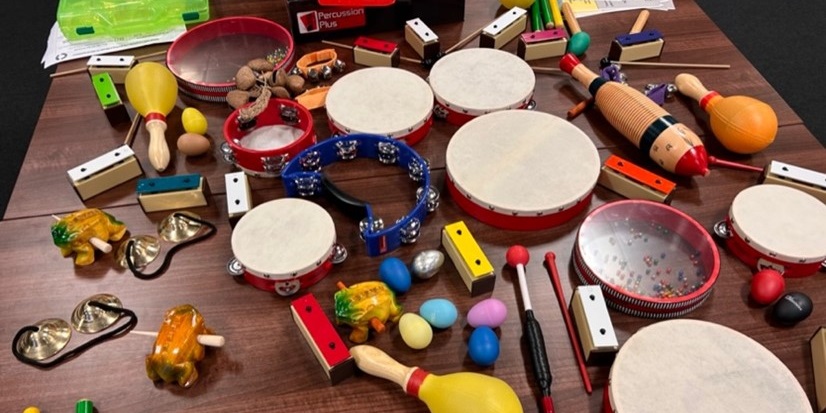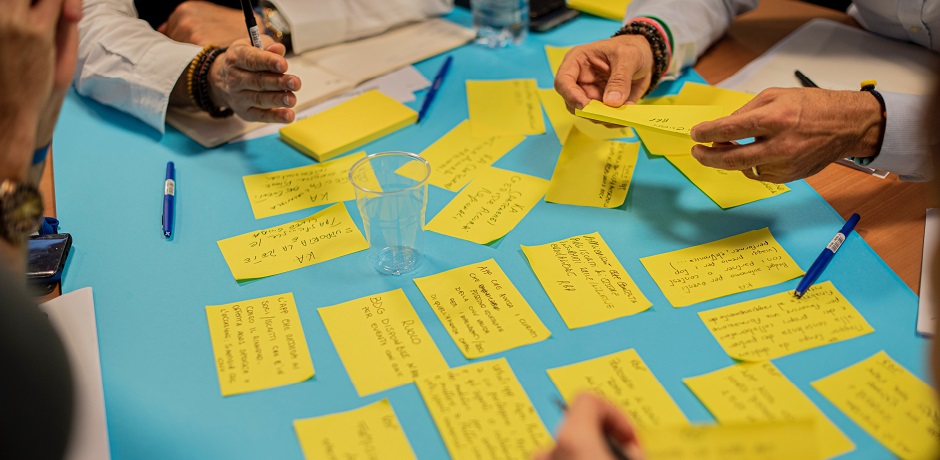)
Using service design methods to strengthen innovation in social care
Innovation is seen as a solution to meet the many challenges facing the social care system, but it is an uncomfortable fact that despite the many innovations developed there is a tendency for them ‘to remain on the margins’. Here, Jessica Kyriacou explains how the design and research team at Social Finance worked with researchers at the LSE. They used tools from service design to codesign solutions to challenges to collaborative innovation in the Adult Social Care sector, around three key themes: lack of knowledge, lack of spaces to innovate, and inelastic systems.
Enabling collaboration to unlock successful innovation
While researchers at LSE CPEC brought in-depth knowledge of social care innovation, researchers at Social Finance brought skills in design research. Design researchers use many techniques to develop practical solutions to address entrenched problems within public services.
Our underlying hypothesis is that collaboration is a critical lever to catalyse innovation. Here we used an ideation process. Working as an interdisciplinary team, in work funded by the NIHR School for Social Care Research, we set out to see whether we could design solutions that would support collaboration between people involved in innovating in the adult social care context.
We started by conducting interviews with social innovators, local authority innovators and tech innovators to uncover the main challenges they faced. We consolidated these into themes, and focus here on three of these themes:
- Knowledge: A lack of knowledge about each other’s organisations and how they work can make collaboration uncomfortable
- Spaces to Innovate: We discovered that innovations often arise from serendipitous connections, partly facilitated by spaces to make connections
- Inelastic systems: Engrained ways of thinking and delivering care are a drag on innovation, particularly when the innovator doesn’t have the freedom to explore divergent ways to do things and ‘disrupt’ the status quo
We then took these barriers to a wider group of people involved in or interested in innovation. We worked with these people in workshops to start to think about what solutions there could be to these barriers, using the ideation process. Here we describe three ideas the group thought were the best.
Solution 1: Reframing innovation
We learned that innovators often don’t have the freedom to explore divergent ways to do things and ‘disrupt’ the status quo. This is perpetuated by organisations they’re working with having ingrained ways of thinking and delivering care. There is also often a view that innovation cannot play a role in ‘fixing the basics’, so it can be one of the first things to fall to the wayside when pressures mount.
To develop solutions we asked ourselves two pressing questions: How might we enable innovators to find a supportive testing ground to explore new ideas? and how might we enable organisations and innovators to have early conversations to find practical ways to to address entrenched problems within public services.
The group proposed, as a solution, the need to change and challenge the way people think about innovation. This might be through linking the development of an innovation culture with practical problem solving or creating a shared sense of crisis to energise people to come together and innovate around everyday problems. The group talked about the potential for developing a set of activities and tools for organisations to use to talk about innovation with their staff and innovation exercises to use in team meetings to break the mysticism around it.
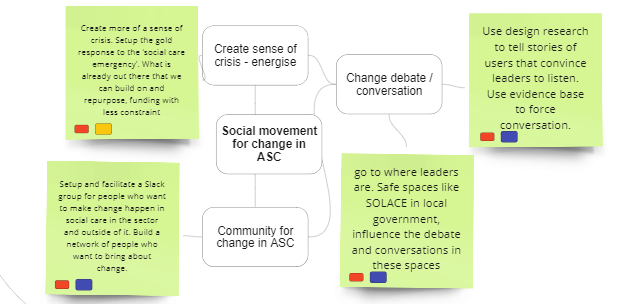
The challenge of reframing innovation generated a number of ideas
Solution 2: Innovation portal
Innovators don’t always know the best way into the organisations they think their services or products will benefit, nor which organisations are looking to solve problems in a similar space. On the other hand, we heard that organisations like local authorities work at a different pace to innovators. We re-framed this problem into an opportunity to support innovators to better understand the organisation they are collaborating with. To focus idea generation in the workshops, we asked ourselves: How might we improve collaborator’s ability to identify the most opportune time to begin innovation and manage changes in pace? and how might we encourage organisations to share fuller information with innovators that will improve their understanding?
The different ideas the group came up with were focussed around the concept of an innovation portal where everyone who is part of the innovation process, from developers through to adopters, can access ideas. Included in the hub could be an idea exchange forum, a central hub or repository of innovations that have been successful and unsuccessful, and a horizon scanning platform to identify potential innovations. The group also thought the hub could support innovators to work with learning partners to reflect on the experience of innovating.
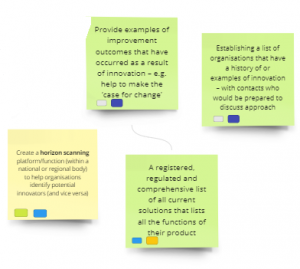
Ideas related to the innovation portal concept
Solution 3: Events repository
Innovations often arise from serendipitous connections, partly facilitated by spaces to make connections. We therefore sought ways for innovators to make connections with people who are open and ready to think about positive change and disruption. In the workshop we worked through two aspirational statements: How might we raise awareness of existing resources, events and networks in local areas to improve collaboration? and How might we support innovators and organisations to explore networking and collaborative spaces to leverage the opportunity to explore innovation?
The different ideas the group came up with centred around: an online repository that would allow people to tag events so they could decipher if it would be worthwhile for them to join (e.g. using categories like focus, place, purpose, strategic aims etc.); a ‘dating’ app for innovators to connect with organisations who might be interested in their services or products; and a space for establishing communities of practice around specific issues or types of innovations.
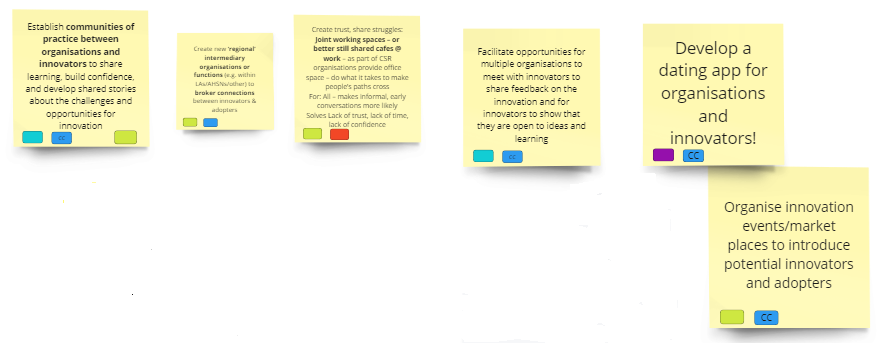
Ideas and approaches generated to increase connections between innovators
What's next?
The ideation process provided a structure through which some of the challenges people face innovating in social care can be thought through and addressed. Our next step is to develop these ideas into service concepts so that we can then begin to test them. In the coming months we will be setting up a Research, Innovation and Improvement Network to provide a space for people to come together around problems facing people who are trying to innovate. One of our propositions for the network will be to begin prototyping these ideas and piloting them on a small scale, then coming back together to share what they have learnt so that we can understand more about these challenges. If you’re interested in joining the network do get in touch with us at sasci@lse.ac.uk.
Read NIHR Social Care Speciality posts here →


